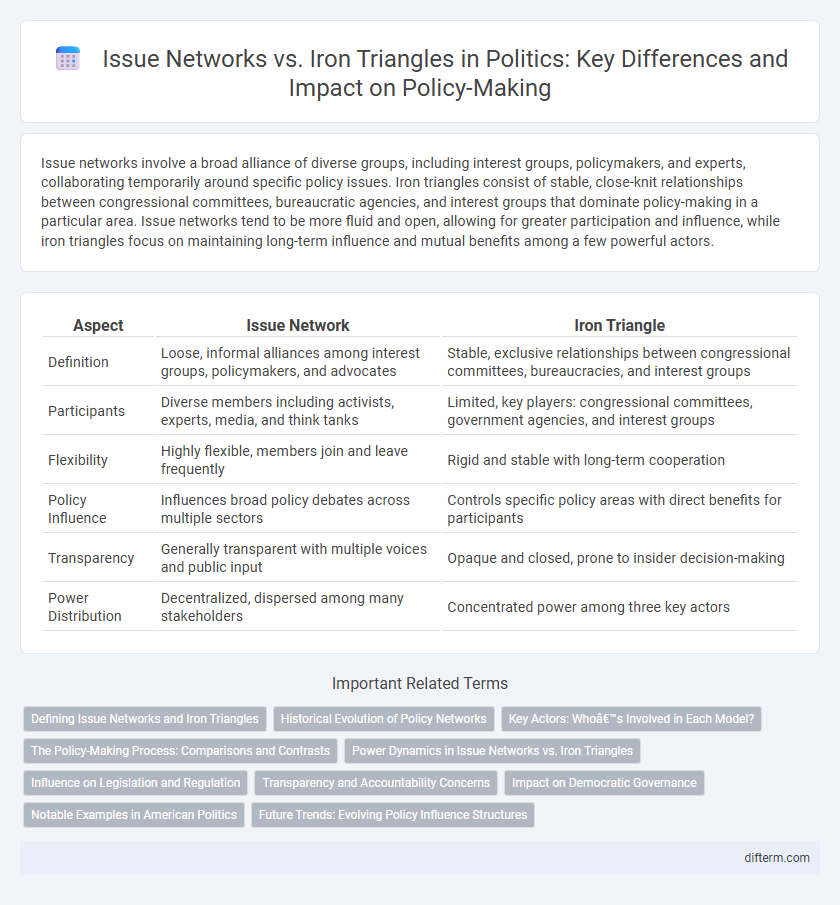Issue networks involve a broad alliance of diverse groups, including interest groups, policymakers, and experts, collaborating temporarily around specific policy issues. Iron triangles consist of stable, close-knit relationships between congressional committees, bureaucratic agencies, and interest groups that dominate policy-making in a particular area. Issue networks tend to be more fluid and open, allowing for greater participation and influence, while iron triangles focus on maintaining long-term influence and mutual benefits among a few powerful actors.
Table of Comparison
| Aspect | Issue Network | Iron Triangle |
|---|---|---|
| Definition | Loose, informal alliances among interest groups, policymakers, and advocates | Stable, exclusive relationships between congressional committees, bureaucracies, and interest groups |
| Participants | Diverse members including activists, experts, media, and think tanks | Limited, key players: congressional committees, government agencies, and interest groups |
| Flexibility | Highly flexible, members join and leave frequently | Rigid and stable with long-term cooperation |
| Policy Influence | Influences broad policy debates across multiple sectors | Controls specific policy areas with direct benefits for participants |
| Transparency | Generally transparent with multiple voices and public input | Opaque and closed, prone to insider decision-making |
| Power Distribution | Decentralized, dispersed among many stakeholders | Concentrated power among three key actors |
Defining Issue Networks and Iron Triangles
Issue networks consist of diverse, fluid coalitions of interest groups, policymakers, and experts that collaborate temporarily to influence policy decisions on specific issues, characterized by their openness and adaptability. Iron triangles are stable, tightly-knit relationships among congressional committees, bureaucratic agencies, and interest groups that create closed policy-making sub-systems, often resulting in mutually beneficial but less transparent outcomes. The contrast lies in issue networks' dynamic, broad participation versus iron triangles' fixed, exclusive power structures within the political process.
Historical Evolution of Policy Networks
The historical evolution of policy networks reveals a shift from rigid iron triangles--comprising congressional committees, bureaucratic agencies, and interest groups--to more fluid and diverse issue networks involving multiple stakeholders such as media, think tanks, and advocacy groups. Iron triangles were dominant during the mid-20th century, characterized by closed, stable relationships influencing specific policy areas. Contemporary issue networks reflect changes in communication technology and political complexity, enabling wider participation and dynamic alliances that challenge traditional power structures in policymaking.
Key Actors: Who’s Involved in Each Model?
Issue networks consist of diverse actors including interest groups, policy experts, media, and congressional staffers who collaborate temporarily to influence public policy on specific issues. Iron triangles involve a stable, mutually beneficial relationship between congressional committees, bureaucratic agencies, and interest groups, focusing on long-term policy implementation and advocacy. The dynamic between the fluidity of issue networks and the rigidity of iron triangles shapes the policymaking process in distinct ways.
The Policy-Making Process: Comparisons and Contrasts
Issue networks consist of diverse actors including interest groups, policymakers, and experts competing to influence policy outcomes through flexible, dynamic relationships. Iron triangles feature stable, mutually beneficial connections among congressional committees, bureaucratic agencies, and interest groups that solidify policy decisions within narrow sectors. The policy-making process in issue networks is more open and fluid, while iron triangles facilitate insular, long-lasting collaborations shaping specific policy areas.
Power Dynamics in Issue Networks vs. Iron Triangles
Power dynamics in issue networks are fluid and dispersed, involving multiple actors such as advocacy groups, media, and policymakers who influence policy through negotiation and collaboration. In contrast, iron triangles consist of tightly-knit, stable relationships between congressional committees, bureaucratic agencies, and interest groups that wield concentrated power to control policy outcomes. Issue networks promote diversity and adaptability, while iron triangles often prioritize entrenched interests and maintain consistent policy influence.
Influence on Legislation and Regulation
Issue networks involve diverse stakeholders such as interest groups, policymakers, and media, creating a dynamic influence on legislation and regulation through open debate and shifting alliances. Iron triangles consist of stable, close-knit relationships among congressional committees, bureaucracy agencies, and interest groups, exerting consistent and focused control over policy outcomes. The flexible structure of issue networks allows for broader participation in regulatory processes, while iron triangles often lead to entrenched policy decisions benefiting specific interests.
Transparency and Accountability Concerns
Issue networks offer greater transparency and accountability through diverse stakeholder participation and open information flow, contrasting with iron triangles that operate with closed, mutually beneficial relationships among bureaucracies, interest groups, and congressional committees. The opaque nature of iron triangles often limits public oversight and fosters entrenchment of special interests, raising concerns about democratic responsiveness. Enhanced transparency in issue networks promotes broader scrutiny and reduces the risk of policy capture by narrow interests.
Impact on Democratic Governance
Issue networks promote democratic governance by enabling diverse stakeholders, including advocacy groups, media, and legislators, to participate in policy debates, fostering transparency and inclusivity. Iron triangles, characterized by close, stable relationships among interest groups, congressional committees, and bureaucratic agencies, can limit democratic processes by prioritizing narrow interests and reducing accountability. The dynamic, adaptable nature of issue networks contrasts with the rigid, exclusive patterns of iron triangles, thereby enhancing responsiveness to public needs and expanding policy deliberation.
Notable Examples in American Politics
Notable examples of issue networks in American politics include environmental advocacy coalitions influencing the Clean Air Act, where diverse stakeholders such as NGOs, scientists, and bureaucrats collaborate. Iron triangles are exemplified by the relationship among the Defense Department, defense contractors, and congressional military committees, where sustained, closed interactions shape defense policy. These contrasting structures highlight the varying mechanisms of influence within the policymaking process.
Future Trends: Evolving Policy Influence Structures
Issue networks are becoming more dynamic and decentralized, incorporating a wider range of stakeholders such as advocacy groups, think tanks, and digital activists, which challenges the traditional, stable iron triangle model. Advances in technology and social media empower issue networks to rapidly mobilize public opinion and influence policy agendas beyond the closed, reciprocal relationships characteristic of iron triangles. Future policy influence structures will likely emphasize transparency, adaptability, and broader participation, reshaping power dynamics in governance.
issue network vs iron triangle Infographic

 difterm.com
difterm.com